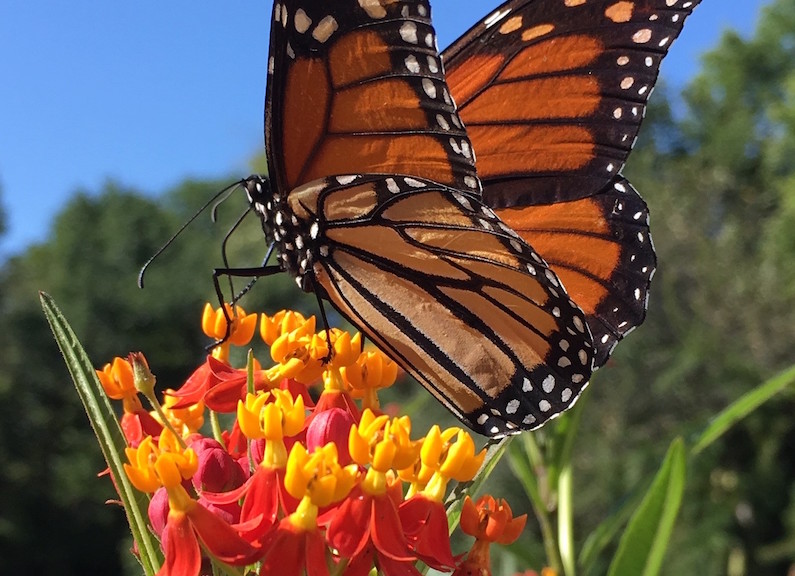Milkweed is a beautiful native plant in the garden, but more importantly it is the only larval host plant of the monarch butterfly. So, when the milkweed disappears, so do the monarchs.
There is a complex range of issues leading to the decreased number of monarchs. Having just one food source is a critical one. Milkweed is the larval host plant of the monarch and serves as the only plant monarchs will lay eggs on. This family of plants is the only food source for larvae.
Planting more milkweeds in the landscape or open areas serves as a great call for action.
When it comes to adding milkweed in the landscape, there are a variety of options available. But as with any plant selection, we must remember the saying “right plant, right place.” Some milkweeds may have better manners in the garden, while others may become a little aggressive in their spreading habits.
Butterfly Milkweed
Asclepias tuberosa, or butterfly milkweed, is the most planted. Butterfly milkweed is a hardy, durable perennial, reaching about two feet in height maintaining a nice rounded habit. It forms a clump and does not spread, and bright orange blossoms cover the plant.
Butterfly milkweed is a Kansas and Missouri native plant. It grows best in well-drained soils. As a native, it is extremely drought tolerant. In fact, wet soil conditions may be its only downfall. It prefers full sun. Some report while this is the easiest to grow, it may not be the favored host for monarchs.
Swamp Milkweed
Asclepias incarnate, or swamp milkweed, is a native perennial plant finding its way into the garden. As the name implies, this milkweed prefers to grow in moist, boggy soils. It can reach a height of three to four feet. Flowers appear in summer with pink tones. It is an excellent choice for the home garden as it is a clumping milkweed. Because it has a tap root system, it does not like to be transplanted.
Like all milkweeds, it has a sticky white sap when broken and large seedpods set after flowering. Swamp milkweed is a good source of nectar, so adults of many butterfly species will visit this plant in the garden.
Green Antelopehorn Milkweed
Asclepias viridis, or green antelopehorn or spider milkweed, is one of the lesser-known plants in this family. It was a common perennial in our pastures and along the roadsides. Green antelopehorn milkweed gets its name from the structure of the milkweed pod, which resembles a horn. The seed pods are green until they dry, bursting open with silky seeds and dispersed by the wind.
Reaching a couple of feet tall and wide, it is clump-forming. It grows best in well-drained soils and is considered very heat and drought tolerant. Compared to the other milkweeds, it has an interesting flower structure hard to describe. The flowers are green with tinges of purple in a large umbel. Not as showy as butterfly milkweed, they still have a unique beauty.
Common Milkweed
Asclepias syriaca, or common milkweed, is a native perennial plant and a favorite of the monarch. Common milkweed should be planted with caution in a perennial garden as it is harder to control. Unlike the other milkweeds, this one spreads rapidly through rhizomes and seeds. It is a colony former and can take over a garden bed. The plant form isn’t the prettiest either, having more of a weedy appearance.
Common milkweed will reach a height of three feet or more and produces white to light pink flowers during the summer. It is very heat and drought tolerant and does well in poor soil conditions. If planted in enriched perennial garden soil, it would spread rapidly and overtake the garden. This milkweed is probably best suited for nature areas or planted in beds where its spread could be controlled.
Tropical Milkweed
Asclepias curassavica goes by either tropical or blood milkweed. Unlike the other plants mentioned, and as the name implies, this one is not native to the Kansas City area and treated as an annual. Tropical milkweed is grown from seed or purchased as a transplant. It gets its name, blood milkweed, from the intense orange-red flower clusters on the plants.
Tropical milkweed will reach three feet or more in a growing season. It grows best in the full sun, but will tolerate very light shade. Butterflies are happiest when they can bask in the warm summer sun. They are more likely to lay eggs in sunnier locations. Being an annual and not having an extensive root system, it will require even moisture for best growth. It is considered relatively drought and heat tolerant.
Balloon Milkweed
Gomphocarpus physocarpa goes by several common names. Balloon milkweed is the more garden-friendly name, but most know it by the name hairy balls. It gets this intriguing name due to its seed pod. Unlike the other milkweed, it forms a light green, rounded, puffy pod with soft prickly-like structures. The entire pod is about the size of a ping pong ball.
This annual milkweed is big. I have seen it reach 5 feet or more. The plant is not showy and does not have the best form. Plant this milkweed in the back of the landscape bed, hidden by more attractive plants. It requires the same culture as the tropical milkweed.
No matter which of the species attract your attention, adding milkweed to the garden is a no-brainer. Many of them are beautiful plants, not only adding beauty to the garden, but helping the monarch on its life’s journey.
For more information, contact the Johnson County K-State Research and Extension at [email protected], 913-715-7050 or johnson.ksu.edu.
Story: Dennis Patton, Horticulture Agent, Johnson County K-State Research and Extension
